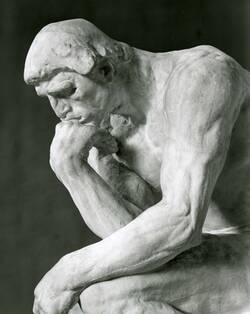On a rock, a man is sitting still, motionless, totally absorbed in his thoughts. His brawny arms and legs tell a different story – perhaps a man of action, a fighter, possibly even a hero. So why has he sat down – and what absorbs him so deeply? And who is he? None of those questions are answered by the title of this work, which French sculptor Auguste Rodin simply called Le Penseur – ‘The Thinker’. A title only describing what we can see.
In 1880, Rodin was commissioned to design the monumental bronze doors for a planned new museum in Paris. His Thinker was intended for the lintel over the doors, so the figure would look down on the people entering the museum. The Thinker might also have been supposed to represent the poet Dante, often depicted wearing a similar style of hat. But the planned museum was never built. So Rodin took figures from his complex design for the doors and declared them as independent works – although outside their original context, their artistic message changed.
Here, Rodin addressed an intellectual crisis in his era. Until then, heroes were often a subject in art, figures who instinctively knew what was right and resolutely turned that conviction into action. This sculpture, though, shows just how difficult deciding on the right action can be. At the same time, Rodin highlights how, for the modern individual, reflection, mulling things over, may be the most important action – one even heroic in its own right.
Further Media
- Location & Dating
- 1881-1883 (draft), 1903 (enlarged version)
- Material & Technique
- Plaster, from the piece form, seams of an earlier formation recognizable
- Dimenions
- H: 183,5 cm, B: 102,5 cm, T: 149,0 cm
- Museum
- Skulpturensammlung
- Inventory number
- ASN 4817
